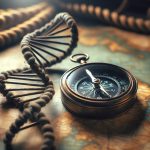The Wisconsin Historical Society serves a dual role as both a state-run institution and a community of members passionate about preserving the rich tapestry of North America’s history, with Wisconsin’s narrative at the heart. In an enlightening conversation, CEO Christian Overland sheds light on how crucial it is to safeguard our historical legacy for future generations. He emphasizes the importance of making history accessible to all, ensuring that past events and stories are not just remembered but understood widely.
Christian also extends an open invitation to individuals keen on tracing their lineage or delving deeper into the American past. The society boasts an impressive collection of records and documents that provide invaluable insights into our ancestors’ lives and times. This treasure trove of information is more than just a resource; it’s a gateway to understanding where we come from and, by extension, who we are today.
By engaging with the society’s resources, genealogy enthusiasts have an unparalleled opportunity to connect dots in their family histories that were previously obscured or lost over time. It’s not only about looking back; it’s about discovering connections that inform our present and shape our collective future.
In essence, the mission of the Wisconsin Historical Society reaches beyond mere preservation. It’s about creating a living dialogue between past and present—a conversation enriched by each discovery within its archival sanctuaries.
My Professional Experience
Holding the position of Ruth and Hartley Barker Director and CEO at the Wisconsin Historical Society in Madison, Christian Overland comes with a rich background steeped in history. With over three decades of experience, his journey has taken him through prestigious institutions like The Henry Ford in Michigan, Historic Deerfield in Massachusetts, and the Minnesota Historical Society. His work is not just a job; it’s a passion fueled by an innate curiosity about our collective past.
Overland‘s professional life revolves around making history accessible to all. He constantly explores how to effectively narrate captivating stories that bridge the gap between the present and our ancestors’ lifetimes. This task involves asking critical questions: What purpose does history serve? Can it motivate us to craft a brighter future? And most importantly, how do we trace back our roots to truly understand ourselves?
At its core, Overland‘s mission is about more than preserving artifacts; it’s about sparking conversations that inspire reflection and action towards creating a better world. Through his efforts, he aims to turn historical insights into tools for change, nurturing a deeper appreciation for where we’ve come from—and where we’re headed.
Explaining the Origin of WHS
Established in 1846, just before Wisconsin achieved statehood, the Wisconsin Historical Society embarked on a mission to preserve North American history. This vision was inspired by the burgeoning westward expansion of the United States at that time. What began as an ambitious project has blossomed into an extensive network comprising twelve historical sites and museums, alongside a main hub that includes a library, historic preservation office, archives reading room, and a dedicated facility for archiving national collections.
The scope of this institution’s collection is both vast and varied, covering not only events from North America but also weaving international narratives into its tapestry. It stands out as one of the foremost repositories of American history, trailing only behind the Library of Congress in its comprehensive assembly of resources. Among its prized possessions is an impressive array of American newspapers—second in quantity worldwide—and Martin Waldseemüller’s world map from 1506-1513, recognized as the earliest depiction of North America still existing today.
Moreover, with annual publications ranging between 15 to 20 titles and housing one of America’s top five genealogical resource collections—including books, databases, and maps from across the country—the Society is a goldmine for historians and genealogy enthusiasts alike.
Not stopping at merely chronicling past events through documents and artifacts,the Society also prides itself on maintaining significant social justice collections that document pivotal moments in the American Civil Rights movement. Its industrial manufacturing compilations feature noteworthy archives like those pertaining to Singer Sewing Machine and McCormick-International Harvester. These collections offer insights not just into regional histories across the United States but also touch upon global stories.
In essence, this institution serves as an invaluable guardian of our past—both celebrated and solemn—offering future generations access to unfiltered stories that have shaped our collective experience.
Making history accessible to everyone
Making history accessible to all is a pressing matter in today’s world. The collections at the Wisconsin Historical Society, for instance, hold treasures that have long been appreciated by academics. These include documents from key figures in American history such as Thomas Jefferson and Daniel Boone. Yet, the goal now is to open these resources up to everyone across the globe.
The heart of democratizing history lies in bridging it with modern life through digital means. By digitizing collections, we not only preserve them but also make them easily shareable and understandable for people everywhere. This initiative aligns with the belief that connecting individuals with historical narratives encourages them to contribute positively to the future.
Understanding our roots and how our forebears shaped current societal norms can significantly impact individuals and families alike. In this era, learning from both past triumphs and mistakes could prove invaluable. Technologies like DNA analysis further complement digital archives by offering personal insights into one’s ancestry, thereby enriching their understanding of historical contexts.
However, embracing these technologies comes with a responsibility towards ethical usage and maintaining trust within communities by ensuring authenticity and relevance of information shared. Essentially, it’s about striking a balance between leveraging modern tools for educational purposes while holding steadfast to principles of integrity and authenticity.
Assisting members in tracing their ancestry

The Wisconsin Historical Society is deeply committed to opening up the world of genealogy and ancestry exploration to the public. With a dedicated team that includes a full-time genealogist, they’re making significant strides in helping individuals trace their family roots. Through an extensive reference library, managed by both staff and archivists, anyone interested in piecing together their family history has access to an invaluable resource.
Understanding one’s origins can dramatically change how they perceive their place in history. The society has recognized this transformative power and offers various educational resources, including webinars that cater to general genealogy interests as well as those focusing on specific ethnic backgrounds like German, Native American, and Jewish ancestries. This approach not only facilitates personal discovery but also promotes a deeper connection with one’s heritage.
Moreover, the importance of documenting historical events such as scientific breakthroughs, environmental shifts, or health crises cannot be overstated. In light of the recent global pandemic, the society undertook an innovative journaling project inviting people worldwide to contribute their personal accounts of living through these challenging times. This initiative aims at ensuring future generations have a comprehensive understanding of our era’s challenges and responses.
One pivotal revelation from this period was recognizing a gap in our historical records—the absence of ordinary voices from past pandemics like the one in 1918. By encouraging today’s population to share their experiences, we’re not just recording history; we’re capturing the human spirit’s resilience amidst adversity.
In essence, what makes us who we are is intricately linked to where we come from. The Wisconsin Historical Society‘s efforts provide valuable tools for individuals eager to discover their ancestors’ stories—stories that might inspire them or offer lessons for future challenges. It’s about creating bridges between past and present so that learning from history becomes not just an academic exercise but a journey filled with personal significance and collective wisdom.
How do the 1918 flu outbreak and today’s pandemic compare?
The 1918 influenza outbreak and the current COVID-19 pandemic share similarities, particularly in their prevention strategies. Both eras emphasized the importance of keeping a safe distance and wearing masks to curb virus transmission. However, a notable advancement in our time is the availability of vaccines against COVID-19, though access varies globally.
Originally termed quarantine in America, social distancing was recognized during the 1918 flu as an effective measure to separate those infected from healthy individuals. Public health systems were established at various levels to manage the spread, which was notably exacerbated by mass transportation like trains and rivers.
In examining historical parallels to assist the Wisconsin Department of Health Services with COVID-19, we uncovered that modern travel hubs resemble past spread vectors. The habit of stopping for necessities while on road trips today mirrors how transit routes once facilitated disease dissemination.
Mask usage has evolved over time; its necessity wasn’t as understood during the 1918 flu due to limited medical technology. Antibiotics weren’t available and viruses couldn’t be easily detected until after the electron microscope’s invention in 1932.
Post-1918 saw significant medical breakthroughs that enriched our collection of historical artifacts at the Wisconsin Historical Society. Today, we continue this practice by gathering items that reflect recent medical innovations such as hospital face shields designed by companies like GE Health, testing equipment, protocols for treatment, and firsthand accounts from healthcare professionals.
Both pandemics underscore human resilience in facing health crises—and highlight progress made since then. However, it’s clear we are still navigating through these challenging times towards recovery—a journey future historians will have more clarity on when reflecting back on our era.
What do you think about using sites like Ancestry or Family Tree DNA to learn about history?
In collaboration with leading enterprises in the realms of family lineage and DNA studies, such as Ancestry.com, efforts are underway to make genealogical records more accessible. This initiative focuses on converting a wealth of documents into digital format. These documents range from vital statistics like death, marriage, and birth certificates to professional licenses across various trades. Moreover, the archival treasure trove includes extensive data on individuals’ professions gleaned from census records, petitions, alongside other state and county resources.
The census in the United States serves as a decennial snapshot that captures the essence of people’s lives — what they do for a living, who they live with, and their passions. The move toward digitizing these insights aims to bridge historical records with modern-day family history research.
Highlighting its unique contributions to this field is the Wisconsin Historical Society, which boasts not only an impressively ancient map of North America but also a rich collection of 27,000 maps. There lies untapped potential in re-examining these maps through the lens of DNA tracing technology. Imagine connecting your familial roots to a specific locale based on your DNA test results — it opens up exciting avenues to explore ancestral trails using historic maps.
The essence of delving into one’s family history transcends mere names and dates; it offers a profound understanding from both individualistic viewpoints and broader societal perspectives. The society enriches this exploration further by providing access to an extensive array of newspapers that paint vivid pictures of life across different eras.
To wrap things up succinctly: while DNA tests offer intriguing insights into one’s ancestry, they don’t tell the whole story on their own. The collections at the Wisconsin Historical Society envelop those findings in rich contexture enabling an immersive journey through history beyond mere genetics. Marrying DNA analysis with detailed historical accounts paves the way for unraveling comprehensive narratives about our ancestors’ lives.
Guidance on saving family history and stories for future generations
In our online seminars, specialists often dive into the nuances of keeping genealogical treasures safe. Many individuals approach us with their own research, seeking advice on safeguarding these precious records in both digital realms and tangible forms. Handling inquiries on maintaining historical documents to ensure they remain unspoiled and available for posterity is part of our routine.
The topic of self-publishing has gained traction alongside DNA analysis in today’s tech-savvy era. We guide folks to resources enabling them to craft their unique family history books. Our method of historiography empowers individuals to consolidate their findings into a bespoke narrative. With a repository boasting over 40,000 such works, this tradition has deep roots stretching back generations.
For those intrigued by tracing and preserving their lineage, Wisconsinhistory.org’s Research Your Family History department stands ready to assist. Here, one can find all the tools needed to embark on a journey through time, piecing together the puzzle of one’s ancestry.
What does the future look like for saving history?
Today’s efforts in historical preservation are taking a giant leap forward with the initiative to save and organize blueprints of both new and old structures, even those hidden beneath the earth or water. This task involves pinpointing and recording the remnants of shipwrecks in the Great Lakes as well as terrestrial buildings. Such endeavors pave the way for future generations to delve into their past, exploring where their forebears lived, labored, and prayed.
The push towards this exciting future is powered by technological innovations that have significantly enhanced our ability to locate these sites accurately. The Wisconsin Historical Society is leading this digital revolution by creating a prototype that could redefine how we interact with historic data across various platforms.
A key development is the introduction of a digital system designed to act as a repository for vast amounts of geolocation information. This system will allow individuals to access and sift through data effortlessly, aiding them in piecing together their family histories or satisfying their curiosity about specific locations. The idea is not just about collecting data but making it user-friendly and relevant for everyone interested.
Additionally, there’s an ambitious project underway in Wisconsin: erecting a museum dedicated to celebrating North American history while weaving community narratives into its fabric. These stories aim to bridge past and present, fostering a sense of belonging among community members. By making these narratives accessible, we anticipate enriching public understanding of history which in turn could yield significant benefits across societal, cultural, and economic landscapes.
In essence, these projects championed by the Wisconsin Historical Society represent more than just archival pursuits; they embody an inclusive approach towards preserving our collective memory while encouraging exploration and connection within communities.


















